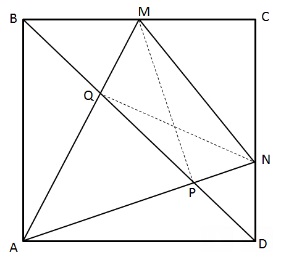Let P and Q be the points where AN and AM intersect the diagonal BD, respectively. It is noted that ∠QAN=∠QDN=45∘.Thus, AQND is a cyclic quadrilateral, therefore implying that ∠AQN=90∘.

This in turn implies that ΔAQN is a right-isoceles triangle with AN as the hypotenuse. Thus, AQ=AN2–√.
The same argument can be employed to show that AP=AM2–√.
Now, since triangles APQ and AMN share a common vertex angle A, we have, Area(ΔAPQ)Area(ΔAMN)=AQ⋅APAM⋅AN. However, from the conclusions in the previous two paragraphs, we have AQAN=APAM=12–√.
This therefore implies that Area(ΔAPQ)Area(ΔAMN)=12, or equivalently, Area(ΔAPQ)Area(MNPQ)=1, as claimed by the problem.
The problem, due to V. Proizvolov, appeared in Kvant - a popular Russian magazine - (#1, 2004, M1895), with a solution in a later issue (#4, 2004).










